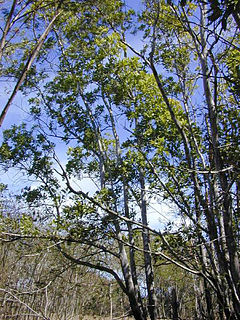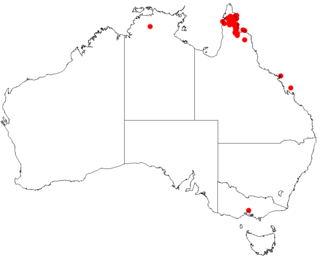
Acacia auriculiformis, commonly known as auri, earleaf acacia, earpod wattle, northern black wattle, Papuan wattle, and tan wattle, akashmoni in Bengali, is a fast-growing, crooked, gnarly tree in the family Fabaceae. It is native to Australia, Indonesia, and Papua New Guinea. It grows up to 30m tall. Acacia auriculiformis has about 47 000 seeds/kg.

Western Province is a coastal province in southwestern Papua New Guinea, bordering the Indonesian province of Papua. The provincial capital is Daru. The largest town in the province is Tabubil. Other major settlements are Kiunga, Ningerum, Olsobip and Balimo.

Acacia pycnantha, most commonly known as the golden wattle, is a tree of the family Fabaceae native to southeastern Australia. It grows to a height of 8 m (26 ft) and has phyllodes instead of true leaves. Sickle-shaped, these are between 9 and 15 cm long, and 1–3.5 cm wide. The profuse fragrant, golden flowers appear in late winter and spring, followed by long seed pods. Plants are cross-pollinated by several species of honeyeater and thornbill, which visit nectaries on the phyllodes and brush against flowers, transferring pollen between them. An understorey plant in eucalyptus forest, it is found from southern New South Wales and the Australian Capital Territory, through Victoria and into southeastern South Australia.

Acacia cyclops, commonly known as coastal wattle, cyclops wattle, one-eyed wattle, red-eyed wattle, redwreath acacia, western coastal wattle, rooikrans, rooikrans acacia, is a coastal shrub or small tree in the family Fabaceae. Native to Australia, it is distributed along the west coast of Western Australia as far north as Jurien Bay, and along the south coast into South Australia. The Noongar peoples of Western Australia know the plant as wilyawa or woolya wah.

Acacia, commonly known as the wattles or acacias, is a large genus of shrubs and trees in the subfamily Mimosoideae of the pea family Fabaceae. Initially, it comprised a group of plant species native to Africa and Australasia, but it has now been limited to contain only the Australasian species. The genus name is New Latin, borrowed from the Greek ἀκακία, a term used by Dioscorides for a preparation extracted from the leaves and fruit pods of Vachellia nilotica, the original type of the genus. In his Pinax (1623), Gaspard Bauhin mentioned the Greek ἀκακία from Dioscorides as the origin of the Latin name.

Senegalia rugata, commonly known in India as Shikakai, is a spiny climbing shrub native to China and tropical Asia, common in the warm plains of central and south India. It is renowned as a raw material for shampoo, while the leaves and young shoots are often eaten. Archaeobotanical evidence shows its use for hair care in the pre-Harrapan levels of Banawali, some 4500–4300 years ago.

Acacia aulacocarpa, also known as New Guinea wattle or golden flowered salwood, is an Australian shrub or tree in the family Fabaceae. It is found in northern Australia, Papua New Guinea, Irian Jaya and parts of Indonesia.

Black wattle is the common name for a number of species of trees that are native to Australia, as listed below:

Acacia mangium is a species of flowering tree in the pea family, Fabaceae, that is native to northeastern Queensland in Australia, the Western Province of Papua New Guinea, Papua, and the eastern Maluku Islands. Common names include black wattle, hickory wattle, mangium, and forest mangrove. Its uses include environmental management and wood.

The hoary wattled bat is a species of vesper bat found in northern Australia and Papua New Guinea. Two subspecies are currently recognised:

Wattle Day is a day of celebration in Australia on the first day of September each year, which is the official start of the Australian spring. This is the time when many Acacia species, are in flower. So, people wear a sprig of the flowers and leaves to celebrate the day.

Acacia myrtifolia, known colloquially as myrtle wattle, red stem wattle or red-stemmed wattle, is a species of Acacia native to coastal areas of southern and eastern Australia.

Acacia 'Scarlet Blaze' is a cultivar of Acacia leprosa originating from Victoria in Australia. It is noted for its unusual red flowers.

The Burrinjuck Nature Reserve is a protected nature reserve on the south west slopes of New South Wales, Australia. The 5,250-hectare (13,000-acre) reserve is located adjacent to the Burrinjuck Dam, with 5,118 hectares of the reserve located on the northern side of the reservoir, and the remaining 89 hectares located on the southern side of the reservoir to the northeast of Black Andrew Nature Reserve. It includes land formerly managed as the Burrinjuck State Forest and Burrinjuck State Recreation Area.

The Black Andrew Nature Reserve is a protected nature reserve located on the south west slopes of New South Wales, Australia. The 1,559-hectare (3,850-acre) reserve is situated on the southern shore of Burrinjuck Dam on the Murrumbidgee River, an important reservoir for the Murrumbidgee Irrigation Area.

Acacia midgleyi, commonly known as Cape York salwood, is a tree belonging to the genus Acacia and the subgenus Juliflorae that is native to north eastern Australia.
Euwallacea perbrevis, commonly known as tea shot-hole borer, is a species of weevil native to South and South-East Asia through to Australia, but introduced to Western countries.
Euwallacea similis, is a species of weevil native in the Oriental region through to Australia but shows a cosmopolitan distribution due to introduction to many parts of the world.

















